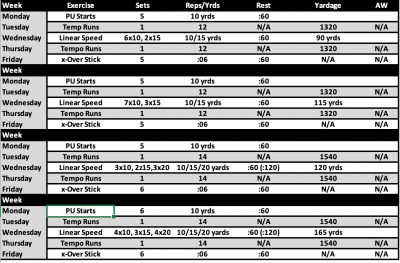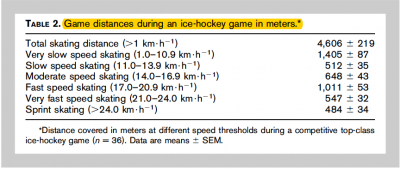Anthony Donskov
Dosing Volume Using the High/Low Model for Ice Hockey
- Font size: Larger Smaller
- Hits: 5528
- Subscribe to this entry
- Bookmark
I’ve gotten several e-mails lately regarding our energy system work for our hockey players at Donskov Strength and Conditioning. Typically, during the off-season, players start with four weight room touch points/week and slowly move to three as ice touches start to increase (more can be found here). The plan is under-pinned by the high-low model famously pioneered by Charlie Francis. During a weekly micro-cycle, three high days are programed consisting of acceleration and sprint-based work, and two low days consisting of tempo runs. This will change ever so slightly three weeks prior to training camp when alactic capacity and lactic power work will be programed in preparation for training camp. A four-week snapshot can be found below.

Monday/Wednesday/Friday = high days. Tuesday/Thursday = low days
In terms of dosing volume void of GPS technology, we have relied on research. In particular, a research study by Lignell et al (2018) investigating the analysis of high intensity skating in high caliber ice hockey. Here are several important findings based on a sample size of 36 National Hockey League players using multiple camera computerized tracking system (Amisco Pro):

Key Findings:
- Total skating distance covered during a game was approximately 4,606 meters (2.8 miles)
- Of the total distance, 31%, 11%, and 14% was covered at very slow speed, slow speed and moderate speed.
- Of the 4,606 total meters, 2,042 consisted of high-intensity (44%) efforts. 49%, 27%, and 24% were covered at fast, very fast and sprint skating speeds
- Players performed 19 sprints during the game with an average length of 19 meters (20 yards). Average sprint speed was 26.2 km/h (16.7 mph)
- Defense covered 29% more skating distance than forwards
- There was no difference in high-intensity skating between forwards and defensemen, but forwards covered 54% more distance by high-intensity skating per time unit
Dosing Volume:
Tempo
- 56% of 4,606 meters = 2579 meters at very slow, slow and moderate speeds. This is equivalent to 2820 yards. This is equivalent to 25 tempo runs (back of end zone to back of end zone)
- We will slowly increase density starting during the off-season to reach this milestone
Speed
- 44% of distance covered was at fast, very fast and sprint skating. 2042 meters = 2233 yards
- Our total summer sprint volume is 2275 yards. This is accomplished on our speed days (Wednesday). We start with approximately 90 yards/session, and slowly build up to 300 total yards/session. This is done prior to lifting. We have found 300 total yards our sweet spot based on total rest/session length (Note: Monday's are ME lifting and acceleration work. Total volume during the summer is < 1000 yards..typically dosed in 10 yard increments with varying start positions)
- On the ice, players performed 19 sprints during the game with an average length of 19 meters (20 yards).We program sprint’s in increments of 10’s, 15’s, 20’s and 30’s
Our goal is simple, prepare the athlete for the demand of sport. We use a combination of current research, underpinned by the high low model. We have found this blend of science and pragmatic application to be optimal for our athletes at the current moment.
References:
- Lignell, E., Fransson, D., Krustrup, P., & Mohr, M. (2018). Analysis of High-Intensity Skating in Top-Class Ice Hockey Match-Play in Relation to Training Status and Muscle Damage. The Journal of Strength & Conditioning Research, 32(5), 1303-1310.
